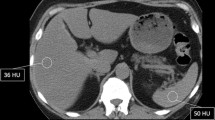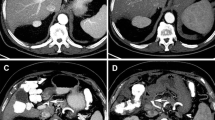Abstract
Purpose
To retrospectively evaluate gadoxetic acid-enhanced magnetic resonance angiography (MRA) using controlled aliasing in parallel imaging results in higher acceleration (CAIPIRINHA) technique for mapping hepatic vascular anatomy in potential living liver donors, with CT angiography (CTA) as reference standard.
Methods
82 potential living liver donors who underwent MRA and CTA were enrolled in this HIPAA-compliant IRB-approved study. MRA and CTA images were evaluated by two reviewers in consensus with respect to (1) image quality scores for depiction of the hepatic vessels and (2) accuracy of MRA for determining the hepatic vascular variants with CTA as reference standard. The image quality scores were compared using Fisher’s exact test between MRA and CTA.
Results
The accuracy for determining the hepatic arterial, portal, and hepatic venous variants and segment IV arterial origin was 73, 90, 79, and 55%, respectively, compared to CTA. However, subjective image quality for depiction of hepatic arteries in MRA was significantly lower than CTA (p < 0.001). The portal and hepatic venous image quality was almost equal in both modalities (p = 0.059) except left hepatic vein being depicted better on CT images (p = 0.023).
Conclusion
Gadoxetic acid-enhanced MRA using CAIPIRINHA technique is feasible for mapping hepatic vasculature in potential living liver donors, with moderate accuracy for arterial variants and good to excellent results for hepatic and portal vein variants, compared with CTA. However, the specific delineation of segment IV arterial origin was possible in just over half of the liver donors with MRA.





Similar content being viewed by others
References
Settmacher U, Neuhaus P (2003) Innovations in liver surgery through transplantation from living donors. Chirurg 74:536–546. https://doi.org/10.1007/s00104-003-0675-x
Broering DC, Kim JS, Mueller T, et al. (2004) One hundred thirty-two consecutive pediatric liver transplants without hospital mortality: lessons learned and outlook for the future. Ann Surg 240:1002–1012. https://doi.org/10.1097/01.sla.0000146148.01586.72
Schroeder T, Radtke A, Kuehl H, et al. (2006) Evaluation of living liver donors with an all-inclusive 3D multi-detector row CT protocol. Radiology 238:900–910. https://doi.org/10.1148/radiol.2382050133
Artioli D, Tagliabue M, Aseni P, Sironi S, Vanzulli A (2010) Detection of biliary and vascular anatomy in living liver donors: value of gadobenate dimeglumine enhanced MR and MDCT angiography. Eur J Radiol 76:e1–e5. https://doi.org/10.1016/j.ejrad.2009.07.001
Segedi M, Buczkowski AK, Scudamore CH, et al. (2013) Biliary and vascular anomalies in living liver donors: the role and accuracy of pre-operative radiological mapping. HPB 15:732–739 ((Oxford)). https://doi.org/10.1111/hpb.12042
Streitparth F, Pech M, Figolska S, et al. (2007) Living related liver transplantation: preoperative magnetic resonance imaging for assessment of hepatic vasculature of donor candidates. Acta Radiol 48:20–26. https://doi.org/10.1080/02841850601045146
Lee MS, Lee JY, Kim SH, et al. (2011) Gadoxetic acid disodium-enhanced magnetic resonance imaging for biliary and vascular evaluations in preoperative living liver donors: comparison with gadobenate dimeglumine-enhanced MRI. J Magn Reson Imaging 33:149–159. https://doi.org/10.1002/jmri.22429
Xie S, Liu C, Yu Z, et al. (2015) One-stop-shop preoperative evaluation for living liver donors with gadoxetic acid disodium-enhanced magnetic resonance imaging: efficiency and additional benefit. Clin Transplant 29:1164–1172. https://doi.org/10.1111/ctr.12646
Jhaveri KS, Guo L, Guimarães LAJR, Roentgenol Am J (2017) Current State-of-the-Art MRI for Comprehensive Evaluation of Potential Living Liver Donors. AJR Am J Roentgenol 209(1):55–66. https://doi.org/10.2214/AJR.16.17741.28333540
Lim JS, Kim MJ, Kim JH, et al. (2005) Preoperative MRI of potential living donor related liver transplantation using a single dose of gadobenate dimeglumine. AJR Am J Roentgenol 185:424–431. https://doi.org/10.2214/ajr.185.2.01850424
An SK, Lee JM, Suh KS, et al. (2006) Gadobenate dimeglumine enhanced liver MRI as the sole preoperative imaging technique: a prospective study of living liver donors. AJR Am J Roentgenol 187:1223–1233. https://doi.org/10.2214/AJR.05.0584
Heilmaier C, Sutter R, Lutz AM, et al. (2007) Mapping of hepatic vascular anatomy: dynamic contrast-enhanced parallel MR imaging compared with 64 detector row CT. Radiology 245:872–880. https://doi.org/10.1148/radiol.2453062103
Schroeder T, Malagó M, Debatin JF, et al. (2005) “All-in-one” imaging protocols for the evaluation of potential living liver donors: comparison of magnetic resonance imaging and multidetector computed tomography. Liver Transpl 11:776–787. https://doi.org/10.1002/lt.20429
Lee MW, Lee JM, Lee JY, et al. (2006) Preoperative evaluation of the hepatic vascular anatomy in living liver donors: comparison of CT angiography and MR angiography. J Magn Reson Imaging 24:1081–1087. https://doi.org/10.1002/jmri.20726
Riffel P, Attenberger UI, Kannengiesser S, et al. (2013) Highly accelerated T1-weighted abdominal imaging using 2-dimensional controlled aliasing in parallel imaging results in higher acceleration: a comparison with generalized autocalibrating partially parallel acquisitions parallel imaging. Investig Radiol 48:554–561. https://doi.org/10.1097/RLI.0b013e31828654ff
Yu MH, Lee JM, Yoon JH, et al. (2013) Clinical application of controlled aliasing in parallel imaging results in a higher acceleration (CAIPIRINHA)-volumetric interpolated breathhold (VIBE) sequence for gadoxetic acid-enhanced liver MR imaging. J Magn Reson Imaging 38:1020–1026. https://doi.org/10.1002/jmri.24088
Sahani D, Mehta A, Blake M, et al. (2004) Preoperative hepatic vascular evaluation with CT and MR angiography: implications for surgery. Radiographics 24:1367–1380. https://doi.org/10.1148/rg.245035224
Soyer P, Bluemke DA, Choti MA, Fishman EK (1995) Variations in the intrahepatic portions of the hepatic and portal veins: findings on helical CT scans during arterial portography. AJR Am J Roentgenol 164:103–108. https://doi.org/10.2214/ajr.164.1.7998521
Cheng YF, Chen CL, Huang TL, et al. (2001) Single imaging modality evaluation of living donors in liver transplantation: magnetic resonance imaging. Transplantation 72:1527–1533
Lee VS, Morgan GR, Teperman LW, et al. (2001) MR imaging as the sole preoperative imaging modality for right hepatectomy: a prospective study of living adult-to-adult liver donor candidates. AJR Am J Roentgenol 176:1475–1482. https://doi.org/10.2214/ajr.176.6.1761475
Goyen M, Barkhausen J, Debatin JF, et al. (2002) Right-lobe living related liver transplantation: evaluation of a comprehensive magnetic resonance imaging protocol for assessing potential donors. Liver Transpl 8:241–250. https://doi.org/10.1053/jlts.2002.30403
Park YS, Lee CH, Kim IS, et al. (2014) Usefulness of controlled aliasing in parallel imaging results in higher acceleration in gadoxetic acid-enhanced liver magnetic resonance imaging to clarify the hepatic arterial phase. Investig Radiol 49:183–188. https://doi.org/10.1097/RLI.0000000000000011
Yoo JL, Lee CH, Park YS, et al. (2016) The short breath-hold technique, controlled aliasing in parallel imaging results in higher acceleration, can be the first step to overcoming a degraded hepatic arterial phase in liver magnetic resonance imaging: a prospective randomized control study. Investig Radiol 51:440–446. https://doi.org/10.1097/RLI.0000000000000249
Haradome H, Grazioli L, Tsunoo M, et al. (2010) Can MR fluoroscopic triggering technique and slowrate injection provide appropriate arterial phase images with reducing artifacts on gadoxetic acid-DTPA (Gd-EOB-DTPA)-enhanced hepatic MR imaging? J Magn Reson Imaging 32:334–340. https://doi.org/10.1002/jmri.22241
Tanimoto A, Higuchi N, Ueno A (2012) Reduction of ringing artifacts in the arterial phase of gadoxetic acid-enhanced dynamic MR imaging. Magn Reson Med Sci 11:91–97. https://doi.org/10.2463/mrms.11.91
Davenport MS, Viglianti BL, Al-Hawary MM, et al. (2013) Comparison of acute transient dyspnea after intravenous administration of gadoxetate disodium and gadobenate dimeglumine: effect on arterial phase image quality. Radiology 266(2):452–461. https://doi.org/10.1148/radiol.12120826
Cruite I, Schroeder M, Merkle EM, et al. (2010) Gadoxetate disodium-enhanced MRI of the liver: part 2, protocol optimization and lesion appearance in the cirrhotic liver. AJR Am J Roentgenol 195:29–41. https://doi.org/10.2214/AJR.10.4538
Limanond P, Raman SS, Ghobrial RM, et al. (2004) Preoperative imaging in adult-to-adult living related liver transplant donors: what surgeons want to know. J Comput Assist Tomogr 28:149–157
Author information
Authors and Affiliations
Corresponding author
Ethics declarations
Conflict of interest
There is no conflict of interest.
Rights and permissions
About this article
Cite this article
Jhaveri, K., Guo, L., Guimarães, L. et al. Mapping of hepatic vasculature in potential living liver donors: comparison of gadoxetic acid-enhanced MR imaging using CAIPIRINHA technique with CT angiography. Abdom Radiol 43, 1682–1692 (2018). https://doi.org/10.1007/s00261-017-1379-x
Published:
Issue Date:
DOI: https://doi.org/10.1007/s00261-017-1379-x




